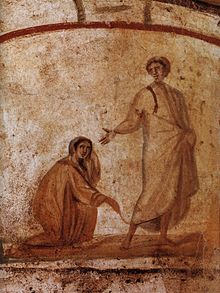- Mark 5
-
For other uses, see Mark V (disambiguation).
Gospel of Mark Mark 5 is the fifth chapter of the Gospel of Mark in the New Testament of the Christian Bible. It relates the story of three miracles of Jesus; an exorcism, a healing, and a possible resurrection.
Healing of the Gerasene Demoniac
See also: Legion (demon)Jesus and his disciples travel to the country of the Gerasenes (some manuscripts have "Gadarenes" to harmonize with Matthew 8:28[citation needed]) across the lake by boat, a region that is in modern Jordan. A possessed man comes to meet them. Mark relates that the man had lived in nearby tombs, and had fought off all attempts to chain him up. He roamed the tombs and hills screaming.
The man falls at Jesus's feet and begs Jesus not to harm him. Jesus asks him what his name is and he replies "My name is Legion,...for we are many". Legion might be a reference to the Roman army. (Miller 24)
They see some nearby pigs and the demons ask if they can be put in the pigs, which Jesus does. The pigs then rush into the lake and drown.
The people tending the pigs run off to town telling everyone what happened and some townspeople come to see for themselves. When they arrive the man is sitting dressed and sane. They are disturbed and ask Jesus to leave the area and he complies. The man asks Jesus to let him follow him, but Jesus tells him to go home to his family and tell them what God has done for him. The man then travels over the Decapolis telling people the story.
This story occurs in Matthew 8:28-34, where there are two possessed men, and Luke 8:26-39.
Jairus' daughter and the woman who touched Jesus' garment
On the other side of the lake Jesus is met by a man named Jairus, a Synagogue Ruler (a rich patron of the local house of worship (Miller 24), who begs Jesus to heal his sick, twelve year old girl. Jesus takes only Peter, James, and John. This story does not occur in the Gospel of John. On the way there, a woman who suffers from chronic "bleeding", perhaps menorrhagia or bleeding from fibroids. (Brown et al. 608) She sneaks up to Jesus and touches his garment, according to Matt 9:20-22 and Luke 8:43-48 (see also Mark 6:53-56, Mark 6#Healing of the sick of Gennesaret) the "fringe of his cloak" [1] (Matt 9:20NRSV), by which she is healed. He turns to see who and she fearfully confesses. He says "Daughter, your faith has healed you. Go in peace and be freed from your suffering."
Men arrive and tell Jairus that his daughter is dead. Jesus brushes them off and says "Don't be afraid; just believe." They arrive at the house and everyone is crying loudly. Jesus assures everyone she is just asleep, goes inside and tells her to get up and she does. Unlike the demon possessed man he tells them not to tell people of these events.
This is also in Matthew 9:18-26 and Luke 8:40-56. Luke keeps the stories of the possessed man and the two women together but Matthew inserts the story of the paralyzed man, calling of Matthew, and the parable of the wineskins found in Mark 2 between these two stories.
References
- ^ Jewish Encyclopedia: Jesus: "Jesus wore the Ẓiẓit (Matt. ix. 20)"; Strong's Concordance G2899; Walter Bauer's Greek-English Lexicon of the NT, 3rd ed., 1979: "κράσπεδον: 1. edge, border, hem of a garment - But meaning 2 is also possible for these passages, dependending on how strictly Jesus followed Mosaic law, and also upon the way in which κράσπεδον was understood by the authors and first readers of the gospels. 2. tassel (ציצת), which the Israelite was obligated to wear on the four corners of his outer garment, according to Num 15:38f; Dt 22:12. ... Of the Pharisees ... Mt 23:5."; Catholic Encyclopedia: Fringes (in Scripture): "It was very likely the tassel of the corner thus thrown over Our Lord's shoulder that the woman with the issue of blood touched ("behind him"), in the circumstance recorded in Matt., ix, 20, and Luke, viii, 44." See also Christianity and fringed garments.
- Brown, Raymond E. et al. The New Jerome Biblical Commentary Prentice Hall 1990 ISBN 0-13-614934-0
- Mark 5 NIV Accessed 27 October 2005
- Miller, Robert J.-Editor The Complete Gospels Polebridge Press 1994. ISBN 0-06-065587-9
Chapters of the Bible Preceded by:
Mark 4 Gospel of Mark Followed by:
Mark 6 Categories:- Gospel of Mark chapters
Wikimedia Foundation. 2010.


